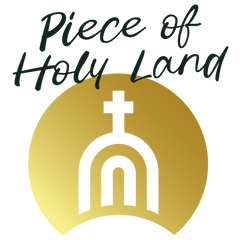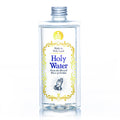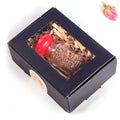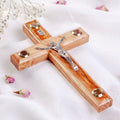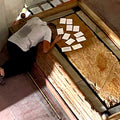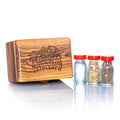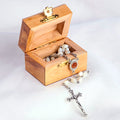Olive Wood Thorn Cross | A Sacred Symbol of Suffering and Triumph
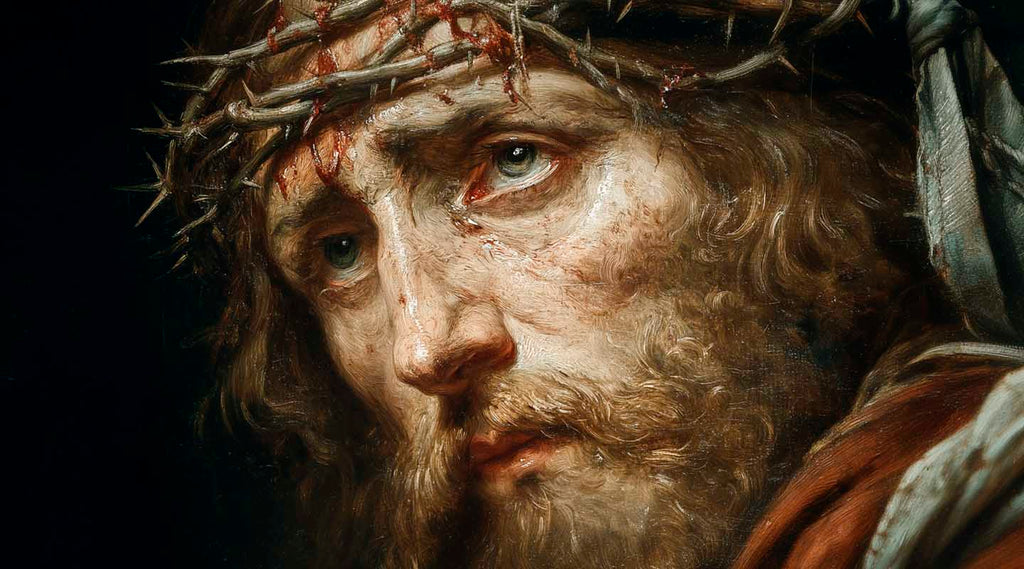
Crafting Faith: The Story Behind the Olive Wood Thorn Cross
The symbolism of the Thorn Cross
The cross is the most recognised sign of Christianity, but the Thorn Cross adds another layer of meaning. In the Gospels, Roman soldiers twisted branches into a crown of thorns, pressed it onto Jesus’ head and mocked Him as “King of the Jews.” This painful diadem, described in Matthew 27 and John 19, was intended as humiliation. For believers, however, it reveals both the depth of Christ’s suffering and the majesty of His kingship. The Olive Wood Thorn Cross captures that tension: it displays the familiar shape of the cross while incorporating carved thorns to remind us of the crown placed on Jesus’ brow. It is a symbol of suffering, obedience and ultimate victory over sin and death. Early Christians often drew simple crosses on catacombs and homes to express their faith; today, a Thorn Cross continues that tradition, inviting contemplation of Christ’s sacrifice every time one’s eye passes over it.
Olive wood from the Holy Land: A sacred material
Olive trees grow slowly and live for centuries, their twisted trunks appearing in Scripture from Genesis to Revelation. King David compared his children to young olive shoots, and the prophet Isaiah used the image of a flourishing olive tree to describe God’s people. The Mount of Olives, where Jesus prayed the night before His crucifixion, was covered with these hardy trees. Artisans in Bethlehem and Jerusalem still work with wood from trees that sprout new branches from ancient roots, ensuring no living tree is harmed. Each piece of olive wood possesses a distinct grain and colour, so no two crosses are alike. When you hold a carved cross, you touch wood that grew in the same land where Jesus taught and healed. This connection makes an Olive Wood Thorn Cross both a work of art and a tangible link to the Holy Land. Its natural tones complement any prayer corner, while its age‑old origins ground your devotion in history and place.
Olive wood tree in Jerusalem

The crown of thorns: From mockery to majesty
Thorns appear early in the Bible as a result of humanity’s fall: “thorns and thistles” were part of the curse pronounced in Genesis 3. When Roman soldiers fashioned a crown of thorns, they turned that curse into a weapon of ridicule. Yet by wearing that crown on the way to Golgotha, Jesus transformed the symbol of sin into an emblem of redemption. He was both suffering servant and conquering King. The carved thorns on a Thorn Cross recall those sharp branches without causing pain; they invite reflection on the paradox of the Gospel, that the Messiah’s path to glory passed through pain. When placed on a wall or held in prayer, the Thorn Cross whispers that God can turn mockery into majesty and curses into blessings. Its design encourages believers to meditate on the humility of Christ, who “humbled Himself by becoming obedient to death, even death on a cross.”
Crosses in Christian tradition
From the earliest days of the Church, believers have looked to the cross as a sign of salvation. Saint Paul called the message of the cross “the power of God” and urged his readers to boast only in the cross of Christ. Throughout the centuries, crosses have adorned churches, monasteries and homes, reminding all who enter that redemption was accomplished through wood and nails. In the East, ornate processional crosses lead liturgies; in the West, simple Latin crosses crown steeples. Pilgrims to Jerusalem have long carried small crosses home as souvenirs, a practice that connects them to the sites of the Passion. The Thorn Cross carries this tradition forward. Whether hung in a living room or placed near a bedside, it becomes a miniature shrine that invites prayer and contemplation. Its thorns point back to the Gospels while its olive wood roots it in the land where Jesus walked. Linking your home to the story of salvation, this cross can inspire daily reverence.
Church of the Holy Sepulchre

From craft to keepsake: How Thorn Crosses are made
Creating a Thorn Cross begins with selecting seasoned olive wood harvested responsibly in Bethlehem and Jerusalem. Craftsmen cut the rough outlines of the cross, then painstakingly shape the arms and the crown of thorns using hand tools. The thorns are carved individually, giving each cross a slightly different profile. After sanding and polishing, the wood’s natural grains emerge, revealing waves of honey, brown and cream. Each finished cross is then blessed and paired with a certificate verifying its origin and authenticity. When you order an Olive Wood Thorn Cross, you receive a one‑of‑a‑kind devotional object and a piece of living heritage from the Holy Land. Because it is handmade, slight variations become part of its charm. Owning such a cross supports local Christian families who have passed down carving skills for generations, preserving a tradition that predates the Crusades.
Integrating the Thorn Cross into your spiritual life
Devotions often need physical anchors. A carved cross provides exactly that. Hang a Thorn Cross above your dining table to remind your family of God’s providence; set it near your prayer chair so it catches the light during morning reflections. If you pray the Rosary or meditate on Scripture, hold the cross between your fingers and let its carved thorns draw you into the mysteries of the Passion and Resurrection. Couples may place a cross in the bedroom as a sign of Christ’s love, while children can learn about Jesus’ sacrifice through its tangible form. During Lent or Holy Week, venerate the cross with a gentle touch, remembering the cost of redemption. When friends or loved ones face trials, gifting them a Thorn Cross can offer comfort and hope. Its presence whispers that suffering is not the end of the story. Complement your cross with other prayerful items like Holy Water from the Jordan River or a simple comfort cross to hold during meditation.
Supporting Holy Land communities through sacred art
Each Thorn Cross begins and ends with real people. Olive wood artisans in Bethlehem and Jerusalem rely on their craft to provide for their families. By choosing a cross carved in the Holy Land, you help sustain these communities and preserve skills that have been passed down since early Christian times. Purchasing genuine Holy Land products also counters the flood of factory‑made replicas. Every cross includes a certificate of authenticity that confirms its origin and ensures that your purchase contributes directly to the livelihood of local Christians. When you display or gift a Thorn Cross, you share in the mission of supporting believers in the land where Jesus walked. This partnership transforms a simple purchase into an act of solidarity and faith. And because each cross carries the story of its maker, it becomes a living reminder to pray for the people of the Holy Land.

Other Holy Land crosses and devotional gifts
While the Thorn Cross holds a special place in Christian devotion, it is part of a wider family of sacred items crafted in Bethlehem and Jerusalem. For those who seek something to hold during prayer, an olive wood comfort cross fits naturally in the palm and offers tactile reassurance. If you prefer a smaller piece for your desk or travel bag, explore the collection of olive wood crosses that come in various shapes, including budded and Eastern designs. To bring blessings into your home, pair your cross with Jordan River Holy Water, drawn from the river where Jesus was baptised, or a rosary containing Holy Water that blends daily prayer with tangible grace. These devotional gifts complement the Thorn Cross and enrich your spiritual practice. They also make thoughtful presents for baptisms, weddings or confirmations, linking recipients directly to the Holy Land’s sacred story.
Pilgrimage and prayer: How the Thorn Cross connects you to the Holy Land
Owning a Thorn Cross is a form of pilgrimage in miniature. Pilgrims journey to Nazareth, Capernaum and the Sea of Galilee to walk where Jesus walked and to pray where He preached. You can explore these sacred places virtually through our in‑depth guides to Nazareth, the Sea of Galilee, Capernaum and the Mount of Beatitudes. By reading about these sites and displaying a Thorn Cross in your home, you create a bridge between your daily life and the landscapes of the Gospels. The cross becomes a prayer companion on your own spiritual journey, reminding you that faith is rooted in real places and events. It links to our article on the <a href="https://www.pieceofholyland.com/blogs/christian-articles/jesus-trail-pilgrimage">Jesus Trail</a>, a modern pilgrimage route connecting Nazareth to Capernaum. When you meditate on your cross, imagine the path from Annunciation to Resurrection, and let it inspire you to grow in humility, gratitude and love.
Embracing the message of the Thorn Cross
The Olive Wood Thorn Cross is a testament to faith carved in wood and thorns. It speaks of suffering transformed into glory, of a King who wore a crown of pain, and of artisans who carve hope into every grain. Displayed in your home or given to a loved one, it tells the story of Calvary and the empty tomb. This cross invites you to remember Christ’s love each time you pass by it and to pray for the land where He lived. By choosing such a cross, you welcome both art and Scripture into your life. May its carved thorns remind you that joy can be born from sorrow and that the wood of the cross remains the tree of life.
Frequently Asked Questions about the Thorn Cross
Q: Why is the Thorn Cross different from a regular cross?
The Thorn Cross incorporates a carved crown of thorns around the beams, recalling the mock crown placed on Jesus during His Passion. This design highlights both His suffering and His kingship. It is hand‑carved from Holy Land olive wood, making each piece unique and deeply symbolic.
Q: Where does the olive wood come from?
Artisans source the wood from olive trees in Bethlehem and Jerusalem. These trees have grown in the same soil that witnessed the life and ministry of Jesus. Responsible pruning ensures that no living trees are harmed, and each cross includes a certificate of authenticity.
Q: What do the thorns symbolise?
The thorns represent the crown placed on Christ’s head during His Passion. Originally intended as mockery, they now symbolise His willingness to bear the curse of sin and transform suffering into redemption. A Thorn Cross invites meditation on this paradox.
Q: Are all Thorn Crosses the same?
No. Because each cross is carved by hand, variations in wood grain and carving details make every piece distinctive. This uniqueness adds to the spiritual value, reminding you that your cross is truly one‑of‑a‑kind.
Q: How can I display my Thorn Cross?
You can hang it on a wall, place it on a shelf, or incorporate it into a prayer corner. Some people position it near their bed for nightly reflection, while others place it near dining or living spaces to remind the family of God’s presence. Its natural beauty complements any décor.
Q: Do other olive wood crosses exist?
Yes. The Holy Land offers a variety of cross designs, including budded crosses and Eastern crosses. If you prefer a handheld devotional, consider an olive wood comfort cross for prayer. You can explore the full collection in our Olive Wood Crosses category.
Q: Can I pair the Thorn Cross with other devotional items?
Absolutely. Many believers combine their cross with Jordan River Holy Water to bless their home or with a rosary that contains Holy Water for daily prayer. These items complement the cross and deepen your connection to the Holy Land.
Q: Why should I buy a cross from the Holy Land?
Purchasing a cross carved in the Holy Land supports local Christian artisans and preserves centuries‑old craftsmanship. It ensures your devotional item originates from the same region where Jesus lived and ministered. Each purchase becomes a small act of solidarity with the Holy Land’s Christian community.
SHARE:

